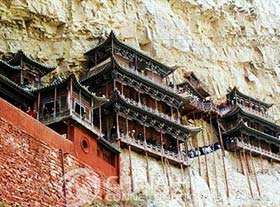 Being the most outstanding Buddhist temples in China, Hanging (Xuankong) Monastery is situated at the foot of the Hengshan Mountain, 75 kilometers southeast of Datong. First built in the late Northern Wei Dynasty in the 6th century and renovated three or four times since, the serried buildings look as though they are supported by a dozen or so slim wooden posts no more substantial than chopsticks. Huge rocks loomed overhead, apparently liable to fall at any moment. The fragile path was strung out along the face of the cliff. There were two reasons to construct the Hanging Temple here. One reason is because there used to be a vital center of communication in old times, it is necessary to construct a temple along this route for the passing pilgrims. But the Hunhe River that flowed past the foot of the cliff was capricious. The other reason is whenever there was a storm there would be a terrible flood. In those days people believed that a golden dragon was the cause of all this trouble, so they thought of a construction of a Buddhist temple to ward off the influence of the dragon.
Being the most outstanding Buddhist temples in China, Hanging (Xuankong) Monastery is situated at the foot of the Hengshan Mountain, 75 kilometers southeast of Datong. First built in the late Northern Wei Dynasty in the 6th century and renovated three or four times since, the serried buildings look as though they are supported by a dozen or so slim wooden posts no more substantial than chopsticks. Huge rocks loomed overhead, apparently liable to fall at any moment. The fragile path was strung out along the face of the cliff. There were two reasons to construct the Hanging Temple here. One reason is because there used to be a vital center of communication in old times, it is necessary to construct a temple along this route for the passing pilgrims. But the Hunhe River that flowed past the foot of the cliff was capricious. The other reason is whenever there was a storm there would be a terrible flood. In those days people believed that a golden dragon was the cause of all this trouble, so they thought of a construction of a Buddhist temple to ward off the influence of the dragon.
The monastery, seeming to cling half way up the cliff, is approached over a bridge and up a stone staircase that has been chiseled from the rock face. The total of 6 main halls and various side rooms above are linked by winding corridors, bridges, and boardwalks, with some amazing glimpsed views of the world below. The most important building is the Three Religions Hall where Buddha, Laotzu and Confucius sit side by side. In recent years, the hall has been repaired and some sections of it have been closed to outside.
The Hunging Monastery contains a good, although small, collection of bronze & iron work, various collections of wood and stone carvings and some clay statues.

